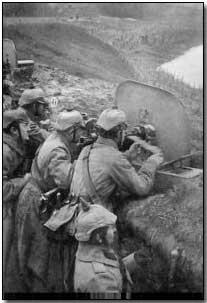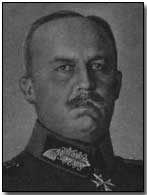Battles - The Second Battle of the Masurian Lakes, 1915
 Also known as the Winter Battle of the
Masurian Lakes - because it opened during a severe blizzard - the Second
Battle of the Masurian Lakes formed part of
Paul von Hindenburg's
plan for a two-pronged decisive push against Russia by the Austro-Germans,
the aim being to force Russia's defeat and so bring about an end to war on
the Eastern Front.
Also known as the Winter Battle of the
Masurian Lakes - because it opened during a severe blizzard - the Second
Battle of the Masurian Lakes formed part of
Paul von Hindenburg's
plan for a two-pronged decisive push against Russia by the Austro-Germans,
the aim being to force Russia's defeat and so bring about an end to war on
the Eastern Front.
Specifically, Hindenburg intended to outflank Russian positions in central Poland, pushing them back beyond the Vistula River.
Hindenburg's plan called for the deployment of two armies in East Prussia - the Eighth and Tenth - set against the Russia Tenth Army, commanded by General Sievers. Siever's army consisted of four corps, positioned north of the Masurian Lakes. This comprised the northern prong of Hindenburg's push against the Russians. The German armies would advance north and south of the fortified Angerapp Line running through the Masurian Lakes.
The plan was sanctioned by German Chief of Staff Erich Falkenhayn despite his reluctance to commit resources in the east - he firmly believed the war was to be won in the west. Falkenhayn agreed to the offensive after deciding that it would present a favourable impression upon potential allies in the Balkans if large-scale action were taken against Russia.
 Begun in the face of a heavy snowstorm on 7
February 1915,
Below's German Eighth Army launched a surprise attack against
the Russian army's southern wing, advancing almost 70 miles within a week.
Begun in the face of a heavy snowstorm on 7
February 1915,
Below's German Eighth Army launched a surprise attack against
the Russian army's southern wing, advancing almost 70 miles within a week.
Falling back, the Russians were attacked by the German Tenth Army - a newly created army sent to the east, consisting of eight divisions - on 9 February from the north, this time against their right flank.
Threatened with encirclement, effective resistance by Sievers' XX Corps (under Bulgakov) in the Forest of Augustow held up the German advance, finally surrendering on 21 February. Their continued resistance had however enabled the remaining three corps to escape. The remnants of the Russian Tenth Army were in disorderly retreat by 14 February.
The Russians had suffered 56,000 casualties during the engagement, but once again German losses were relatively small. Hindenburg's forces however captured huge numbers of Russian prisoners: Ludendorff, Hindenburg's Chief of Staff, claimed 100,000.
Any further German progress eastwards was ended by an attack from the Russian Twelfth Army, under Wenzel von Plehve, on 22 February directed against the German right flank. German attacks further south, under von Linsingen, were far less productive than at the Masurian Lakes. An attack there by the Austro-German South Army through the Carpathians in February and March 1915 was quickly halted and pushed back.
Click here to view a map charting the course of the Second Battle of the Masurian Lakes.
Photographs courtesy of Photos of the Great War website
"Monkey meat" was U.S. slang for the canned beef and carrot ration.
- Did you know?
